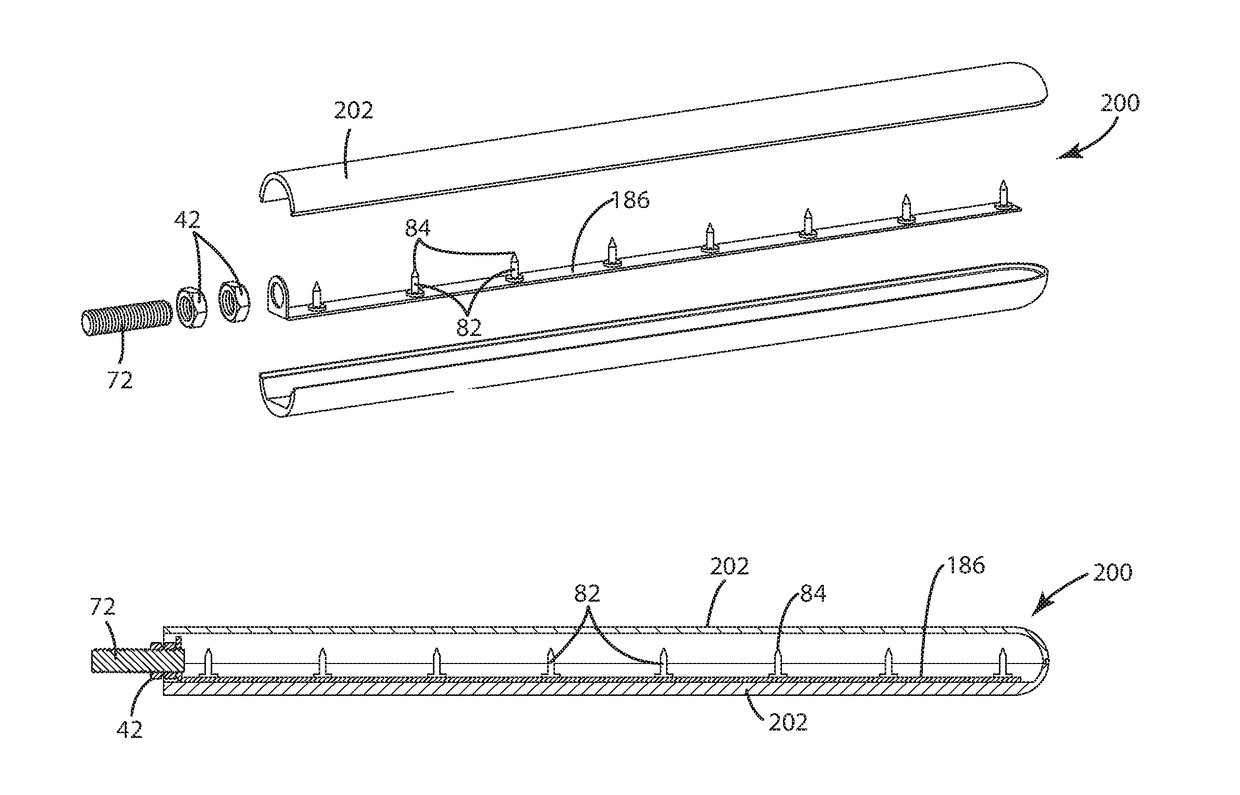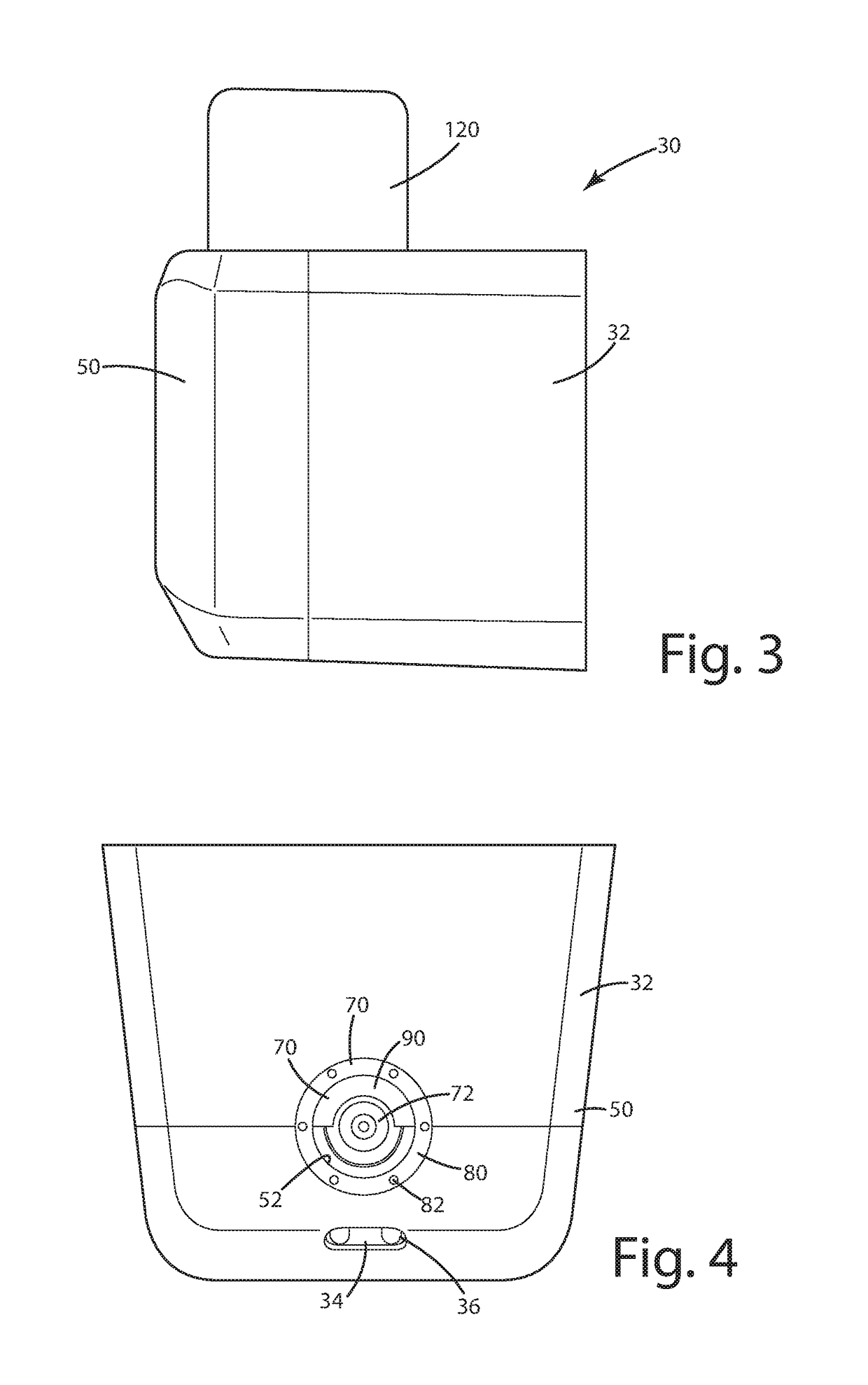Therefore, commonly touched items in public areas and facilities such as doorknobs, handles, fixtures, and other surfaces may spread such infectious diseases and pathogens.
However, contact with door handles, knobs and other fixtures related to the restroom is many times unavoidable.
However, touching many of the surfaces in a restroom after
washing hands or in a kitchen while preparing food particularly in a work place kitchen is unavoidable.
For example, in most restrooms as a person must touch the
handle of the door to exit a restroom, touch the same faucet
handle used to turn on the water or to turn off the faucet, which may recontaminate the just cleaned hands.
In a kitchen, other than door and fixture handles such as faucets, a refrigerator
door handle or the surface of a
microwave and light switches may all be contaminated with various pathogens.
Some people use extra paper towels to cover and touch handles of door or faucets in certain situations, however, generally this is wasteful and adds expense for the facility including increased paper cost as well as increased labor cost for replacing the paper products more frequently.
In addition, the
HVAC system itself may form an environment that is conducive to harmful pathogens growing, such as due to the
moisture present, as well as the air that moves through the
system.
A number of prior methods have been proposed, all having limited success or significant drawbacks in sanitizing various surfaces, particularly on individual's hands, especially for individuals who have chemical sensitivity issues.
The first method is generally more frequent cleaning of such surfaces, however, this increases time and labor costs and generally people are distrustful that the surfaces have been properly cleaned.
In addition, even if the cleaning was thorough and no pathogens exist on the surface, the very first contact by a person may place undesirable infectious agents or pathogens on the surface and any subsequent users may come in contact with such infectious agents or pathogens.
Therefore, the more frequent cleanings do not solve the problem of contaminated surfaces.
While these are generally capable of cleaning the surface, the use is limited to a person actually using them.
A big
disadvantage to these wipes, liquids, or sponges is that they require frequent replacement thereby increasing the cost for the facility.
Many times these anti-bacterial sprays, liquids or wipes are empty creating an undesirable situation for the person using the facility.
In addition, if such sprays, liquids and the like are improperly used, the pathogens may still exist and not be substantially reduced.
In addition to the increased maintenance cost as well as product cost of replacing the battery and the chemical or wet material, generally most people find it undesirable to touch a moist or damp surface such as a moist or damp
door handle, even if the
moisture or liquid is a sanitizing chemical.
In addition, many people do not like the smell or have various chemical allergies to the chemical being used on the
door handle, making it difficult to use that facility.
While such devices prevent the spread of pathogens passed on by contact by
direct exposure to
ultraviolet light, these devices generally are power intensive and require frequent battery changes or recharging unless they are hardwired into a facility's electrical
system.
Therefore, for
doors, wherein they are controlled by a preprogrammed
timer or
motion sensing, their useful life is relatively limited requiring regular maintenance by the facility thereby raising costs.
The positioning of many of these devices is above a door
handle or counter top which places it high enough that smaller people, such as children, may inadvertently look directly at the
ultraviolet lamp which is undesirable and could cause vision issues.
Therefore, the implementation of these devices as sanitizers for various fixtures that cannot fit in an
enclosure has been limited due to their serious drawbacks.
Ozone has been highly desirable for use in
food processing plants, but has had limited other practical applications.
A sanitizing
processing system is generally of limited use because it must control the output of
ozone in a sealed environment.
Therefore, it is used in large industrial only settings and have not been successfully implemented in households or small commercial applications.
More specifically, the application of
ozone sanitizing systems has been extremely limited by the more recent understanding that ozone may cause various health issues including according to the EPA, respiratory issues such as
lung function, decrements,
inflammation and permeability, susceptibility to infection, cardiac affects and more seriously respiratory symptoms including
medication use,
asthma attacks and more.
As the concentration at which ozone effects are first observed depends mainly on the sensitivity of the individual, even some parts per billion
exposure may cause noticeable issues.
Therefore, other than commercial environments where the ozone application must be specifically controlled and these systems are not desirable for a broader implementation in homes, work places and other facilities, where the ozone is not easily contained, such as functioning as a door handle sanitizer for an operational door.
One problem with such systems is that in applications where an external power source is not readily available, batteries for fans, and other means of propulsion such as CO2 canisters must be replaced on a fairly regular basis.
In mechanisms using a fan powered by battery, the fans substantially limits the life of the battery to the point where it needs to be replaced weekly or even bi-weekly in certain environments.
In addition, any sanitizer requiring a mechanism for propelling the ions outward such as the battery-powered fans or
compressed air stop efficiently functioning, without the mechanism for propulsion.
While this circuit is simple and cost effective, it often takes long periods of time for the circuit to stabilize and reach its full output, as illustrated in the graph in FIG. 35, which shows just a small portion of the output at the peak, thereby limiting generation of ions.
For example, in the medical field, one of the biggest problems facing hospitals and clinics is pathogens that are resistant to various chemicals.
Thermals
plasma ion generators produce ions, but are extremely hot, limiting their effective use in close proximity to humans, such as use in a
hand sanitizer.
As with any ions created by an ion generator, many of the ions are unstable and quickly convert back, limiting the effective range of the ions that are useful in sanitizing surfaces, including hands of various pathogens, yet it is desirable to space hands well away from any thermal
plasma field.
Therefore, thermal
plasma devices have serious design constraints when used to sanitize surfaces, such as door handles and other fixtures that are in regular human contact, and any sanitizing of
human body surfaces, such as hands in thermal plasma is not advisable and should be avoided.
Therefore, thermal plasma is generally undesirable because it may cause
corona discharge, which is related to ozone production.
Another drawback to ion generators that use a thermal plasma is the high
power consumption required to generate the thermal plasma.
Battery life of a thermal ion generator would be so short or require such
large capacity batteries, therefore requiring large volumes of space, any use of the ion generator remote from the
power grid would be impractical, and the maintenance requirements would be extremely high in relation to replacing or recharging the batteries.
Therefore, ion generators that use thermal plasma are generally not useful to attach to
doors, walls or other locations where it is difficult to connect them to the
power grid.
In addition, even if a thermal plasma ion generator may be placed in a position to connect to the
power grid, the installation cost is typically high, and the high
power consumption is expensive.
Any ion device only generating a
single type of ion or more specifically, a
single type of charge for the ions are generally not as effective as ion generators producing both positive and negative ions in killing pathogens to sanitize surfaces.
Some sanitizers require expensive sacrificial anodes or cathodes.
Sacrificial anodes or cathodes must be replaced, and in addition, sacrificial anodes or cathodes put pieces of the
anode or
cathode in the environment, typically as ions in a fluid, which may subject the ion generator to numerous additional regulations.
In addition, if either the cathodes,
anode or fluid is depleted, the sanitizer ceases to function as desired.
Similar to the many drawbacks with hand sanitizers, to date no one has found a sanitizing system or assembly that sufficiently sanitizes
HVAC systems or other air handling devices, such as fans, make up air systems and the like.
While many manufactures have tried to eliminate this issue by installing various filters of ever increasing quality, these filters are generally limited to ensure sufficient
airflow, allowing most pathogens to pass through.
In fact, the filter itself may become a
habitat for various pathogens, creating even more problems.
As such, filtering the air, while a good idea, in itself does not provide sufficient protection from airborne pathogens in most HVAC systems.
There currently is no easy way to clean the coils of an
air conditioning unit in most HVAC systems, particularly in vehicles and residential systems, as well as most commercials systems.
Some manufactures have suggested placing
ozone generators in the systems, but ozone has been found to be harmful even in minor quantities to humans, so these prior systems are undesirable.
These
glass tube electrodes are extremely fragile, extremely expensive, and do not have a long
life span, thereby requiring replacement at frequent intervals.
For example, most glass
dielectric electrodes cost over $100 each, and can easily be ruined by vibration.
As such HVAC systems with their vibrations are not conducive to
glass electrode ion systems, even when ignoring their high purchase price and lack of
longevity.
Glass electrode tubes are generally large and bulky and cannot fit in vehicles or ductless mini split systems.
These
metal bars are usually long, large and difficult to position in system, other than large air ducts.
As such, they cannot be used in vehicles, and ductless mini split systems, as they do not fit or when reduced in size do not produce enough ions to be effective.
In addition, these
metal bars operate at extremely
high voltage and with enough amperage to require that during operation they cannot be touched by individuals without danger of possible
electrocution or injury.
As
metal bars are conductive, the risk also may occur if the bar is improperly installed and creates an
electrical connection to the metal ductwork or other items of an HVAC system.
 Login to View More
Login to View More 


